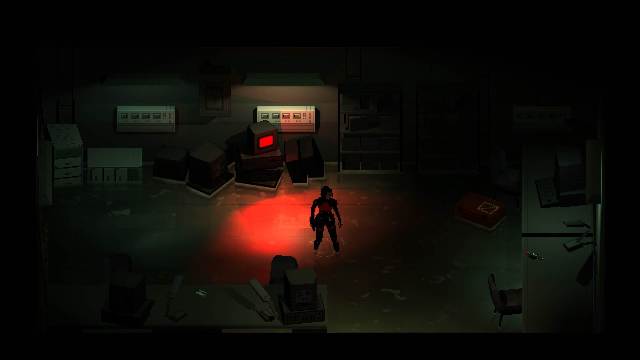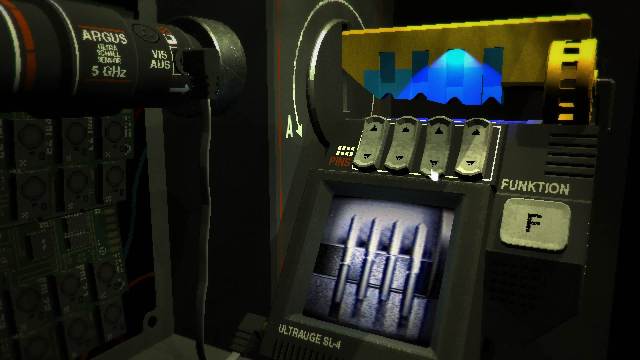Flesh, frights, and gears
There are so many places I could start with Signalis, that it’s hard to know just where. Maybe it’s the long, ominous shadows that often hid an enemy from my sight. The horrifying creatures, waiting to shriek and charge at me. Maybe it’s the incredible style, or the music, or the intricate, tactile puzzles.
It is really hard to succinctly explain what’s so striking about Signalis. In a span of nine or so hours, I went on a trek deeper and deeper down, scraping through layers of steel and concrete until I reached the earth’s flesh, to find the forbidden truths that both my avatar and I sought. It was perilous and emotional, gorgeous and terrifying.

For me, I keep thinking back to the tension I felt in save rooms. I’m standing over a storage box, counting how many bullets I think I’ll need to walk out the door with to get through the next section.
It’s often just barely enough.
Signalis (PC [reviewed], Switch, PS4, Xbox One)
Developer: rose-engine
Publisher: Humble Games, Playism
Released: October 27, 2022
MSRP: $19.99
Signalis is a survival horror game from indie studio rose-engine. It’s the debut of the two-person crew, in the works since 2014.
It would be really easy to describe Signalis by the melting pot of influences you could draw out of it. From survival horror games like Resident Evil and Silent Hill, to its literary influences literally called out in the game itself. From symphonic performances to The King in Yellow, Signalis doesn’t really shy away from its roots. Instead, it feels like a glowing call-back to the golden era of survival horror.

Into the abyss
The player takes on the role of Elster, an android who’s crash-landed on a snow-drenched planet in search of a lost companion. This quest leads her to a mining and re-education camp, falling apart from an unknown terror. Something’s wrong here, which becomes even more apparent as the residents warp and attack you on sight.
The bulk of Signalis is spent in a top-down, tilted view as you move room to room, trying to forge a path ahead. Managing health, ammo, and other resources is critical, even down to stomping on an enemy rather than spending an extra bullet. Because these foes, after enough time, do come back.

Thankfully, rose-engine provides some effective methods for dealing with things that go bump in the dark. There’s a careful balance of tools and equipment. Stun batons give you a free knockdown on most enemies, and thermite flares let you torch their bodies so they won’t get back up. An arsenal that starts with a pistol expands to heavier and more powerful firearms.
But nothing in Signalis is too plentiful. It often felt like I was given just enough ammo and tools to skate by. A rigid amount of storage forced me to make tough decisions. Am I willing to run around with just a few rounds in my revolver, just in case I run across a key item? Should I backtrack to open space in my storage, or use a valuable Repair Spray to free up a spot now?

While the right choice never felt certain, it was comforting that it rarely felt like there was a wrong way to play either. Rose-engine lays out just enough to keep you moving forward puzzle-to-puzzle, without making me feel I needed to reload an old save to undo past mistakes.
The tactile puzzles are highlights of Signalis. Flipping fuses, turning dials, or watching as a box clicks open after a neat solution adds a little extra layer of connection to what’s happening. Many aspects of Signalis feel extremely tangible in this way, from tuning dials to hastily opening the inventory screen to swap to another gun.

Earth’s pores open
And Signalis effortlessly swaps between styles, too. While a large portion of the game is in the top-down view, some moments zoom the camera into a first-person mode, letting you wander much closer. In others, cutscenes play out, flipping between low-poly models and detailed, anime-inspired pixel art. There are even more fascinating stylistic choices that I wish I could talk about without spoiling; suffice to say, if you’re a fan of clicky, analogue pieces of tech, you’ll dig some sections of Signalis.

Where this perspective and art style swapping could feel inconsistent, it instead creates this unsettling tension. Broad strokes give way to fine, grim detail. Text violently slams onto the screen, with fonts and words used as imagery to emphasize the drama. The cut-in to someone’s face, often against a foreboding monotone background, can form punctuating moments of emotion, whether that’s relief or terror.
Cold, distant space
It’s hard to talk too much about the actual narrative behind Signalis without giving too much away, and even then, there are final details I’m still picking apart after the ending. The vision of a star system finally settled by humanity, thanks to the Replika workers like Elster, and the costs associated are fascinating to dig into. Rose-engine has put a ton of lore into the nooks and crannies of the world. Some of it is crucial, for puzzles or story reasons. Others are just welcome bits of detail, fleshing out their universe.
But the setting rose-engine constructs is both grim and beautiful. The nature of labor and work in this world, especially for androids like Elster, is a constant question. And as you both climb deeper into the abyss, who knows what truths you’ll start to uncover?

To be more clear, there’s a fair bit of cosmic, unknowable terror baked into the heart of Signalis‘ horror. It’s an especially sci-fi, technologic kind of cosmic horror too. The kind where synthetic flesh and metal warp to create absolutely terrifying monstrosities. It’s never an outright jump-scare kind of game, but moments in Signalis filled me with an absolute dread of what could be right around the corner.
Remember our promise
Even so, there’s a heart at the center of Signalis that kept me and Elster going. As the thread unspools and I started to grasp just what was happening, I was absolutely magnetized to this setting. I’m frequently a clear-it-once player, but it was really hard to stop myself from immediately starting up a new run after I’d rolled credits on Signalis. It’s a testament to rose-engine that this has stayed in development for so many years, and yet still feels like it’s breaking new ground
It’s honestly hard to find any drawbacks about Signalis; sure, sometimes the lock-on gets a little finicky, or some areas feel a tad drawn out. Those feel like tiny slights against an overall fantastic experience.
For survival horror fans, and lovers of cosmic sci-fi terror, this is a no-brainer. Signalis is a fresh, reinvigorating take on the games that inspired it. Thinking back on each hour, through each locale and their mysteries, I’m repeatedly won over by its impressive style-swapping, carefully balanced tension, brilliant art and sound design, and engaging puzzles. This is a promise worth keeping.













Published: Oct 25, 2022 11:00 am